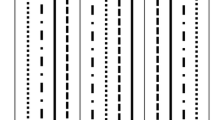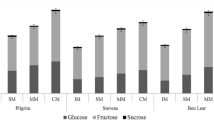Abstract
The quantitative composition of the waxes from 26 different tomato cultivars was determined in order to get an overall view of the contents of the compounds identified in Part I at the ripe red stage and of the variability of results. On average, the tomatoes were covered with a wax layer of 50 µg/cm2, which resulted in 29% of fraction 1 (mainly long-chain hydrocarbons), in 19% of fraction 2 (mainly long-chain alcohols and triterpenols) and in 52% of fraction 3 (naringenin-chalcone).The contents of a multitude of compounds are presented, most of which occurred only in traces. The predominant components were (in decreasing order) naringenin-chalcone, n-hentriacontane, δ-amyrin, n-nonacosane, β-amyrin, α-amyrin and n-tritriacontadiene, all with mean contents exceeding 2 g/100 g. In addition, the wax composition of one individual tomato cultivar was followed during maturation over the stages green, green-orange, red and mature red. Naringenin-chalcone, alkenes and alkenols were first not present but appeared only during ripening. Although the composition of the wax varied considerably, the triterpenols formed a uniform pattern which was similar for the different tomato cultivars and at all stages of fruit development.

Similar content being viewed by others
References
Wilkinson RE, Kasperbauer MJ (1972) Phytochemistry 11:2439−2442
Wilkinson RE, Kasperbauer MJ (1980) Phytochemistry 19:1379−1383
McDonald RE, Nordby HE, McCollum TG (1987) Hort Sci 28:311−312
Leavitt JRC, Duncan DN, Penner D, Meggitt WF (1978) Plant Physiol 61:1034−1036
Baker EA (1974) New Phytol 73:955−966
Haas K (1977) Biochem Physiol Pflanz 171:25−31
Bianchi G (1995) Plant waxes. In: Hamilton RJ (ed) Waxes, chemistry, molecular biology and functions. The Oily Press, Dundee, pp 175−222
Hennig S, Gülz PG (1988) Z Naturforsch 43c: 806−812
Baker EA, Bukovac MJ, Hunt GM (1982) Composition of tomato fruit cuticle as related to fruit growth and development. In: Cutler DF, Alvin KL, Price CE (ed) The plant cuticle. Academic Press, London, pp 33−44
Gülz PG, Müller E, Prasad RBN (1991) Phytochemistry 30:769−773
Gülz PG, Prasad RBN, Müller E (1991) Z Naturforsch 46c: 743−749
Prasad RBN, Gülz PG (1990) Z Naturforsch 45c: 805−812
Freeman B, Albrigo L, Biggs RH (1979) J Am Soc Hort Sci 104:801−808
Bauer S, Schulte E, Thier HP (2004) Eur Food Res Technol 219:223–228
Bauer S (2003) Die Zusammensetzung der Oberflächenwachse von Tomaten, Paprika und Auberginen. Dissertation, University of Muenster, Germany
Acknowledgement
We thank B. Jansen, L. Fennenkötter, R. Laumann, A. Niermann, J. Weber und L. Krüger (Institute of Pharmaceutical Biology and Phytochemistry, University of Muenster) for growing the tomato plants.
Author information
Authors and Affiliations
Corresponding author
Rights and permissions
About this article
Cite this article
Bauer, S., Schulte, E. & Thier, HP. Composition of the surface wax from tomatoes. Eur Food Res Technol 219, 487–491 (2004). https://doi.org/10.1007/s00217-004-0944-z
Received:
Published:
Issue Date:
DOI: https://doi.org/10.1007/s00217-004-0944-z




